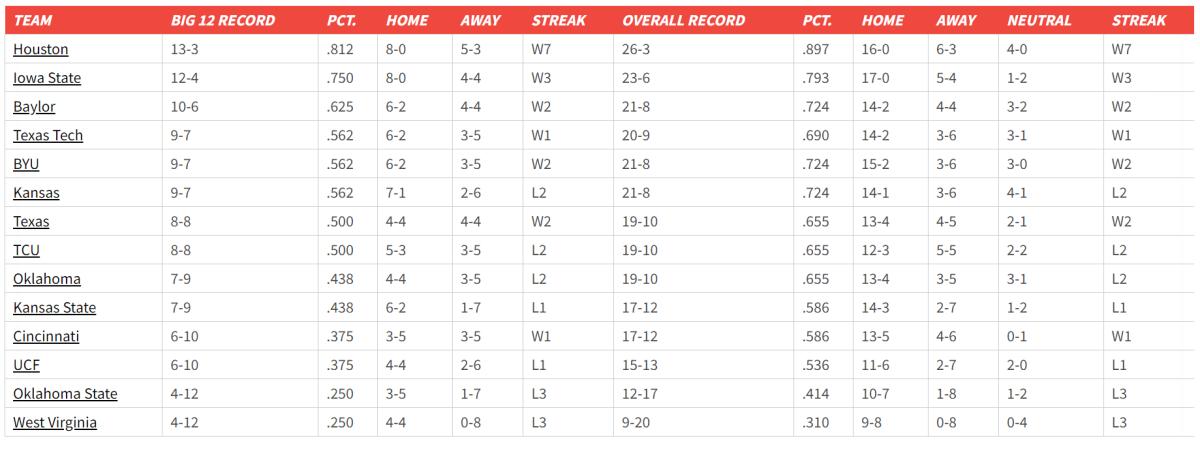BYU is Basketball is Tied for Fourth in the Big 12 Standings
On Saturday evening, BYU basketball stormed back from a 17-point deficit to beat TCU 87-75. With the win, BYU is firmly in the top half of the Big 12 standings. BYU is tied with Texas Tech and Kansas for fourth place in the Big 12.

If the season ended today, Texas Tech would hold the tiebreaker over BYU and BYU would hold a tiebreaker over Kansas. Therefore, BYU would be the fifth seed in the Big 12 tournament. Why? you can read the official rules below, but in short, a three-way tie is resolved with a round-robin format:
Results from the collective head-to-head competition during the regular season among the tied teams in a mini round-robin format, ranking the tied teams by winning percentage from highest to lowest will be used to determine the seeds.
Texas Tech is 2-0 in this round-robin format. BYU is 1-1 (loss to Texas Tech, win over Kansas) in this format, and Kansas is 0-2. Therefore, Texas Tech wins the tiebreaker and BYU is second ahead of Kansas.
A top four seed is an important in the Big 12 tournament. The top four seeds receive byes in the first two games and are automatically in the quarterfinals.

Big 12 Tiebreaker Rules
Here is a summarized version of the tiebreaker rules. There are two sets of rules:
1) for ties involving two teams
2) for ties involving more than two teams
Ties Involving Two Teams
- Results of head-to-head competition. If teams remain tied, then no. 2.
- Each team’s winning percentage versus the team occupying the highest position in the final regular season standings, and then continuing down through the standings until one team gains an advantage.(2-0 is not better than 1-0 or 0-0, 0-0 and 0-1 is not better than 0-2).
- A comparison of the tied teams Conference-games only road winning percentage.
There are a few more tiebreakers if teams still remain tied, but it's highly unlikely the first three rules would not break the tie.
Ties Involving More Than Two Teams
- Results from the collective head-to-head competition during the regular season among the tied teams in a mini round-robin format, ranking the tied teams by winning percentage from highest to lowest will be used to determine the seeds. (2-0 is not better than 1-0 or 0-0, 0-0 and 0-1 is not better than 0-2). This is done to essentially skip a given step if both teams didn’t play the other teams they are being compared to.
- If during this process two teams remain tied with the same winning percentage, the two-team tiebreaking system is used, starting with head-to-head results.
- If during this process more than two teams remain tied with the same winning percentage, a second mini round-robin format is implemented, ranking the remaining tied teams by winning percentage from highest to lowest to determine seeds. If the teams remain tied, then the two-team tiebreaking system is used, starting with head-to-head results.
- If more than two teams are still tied, each of the tied team’s winning percentage versus the team occupying the highest position in the final regular season standings, and then continuing down through the standings, eliminating tied teams with inferior winning percentage until one team gains an advantage.
There are a few more tiebreakers if teams still remain tied, but it's unlikely the first rules would not break the tie.
Follow us for future coverage:
Facebook - @CougsDaily
Twitter - @Cougs_Daily and Casey Lundquist at @casey_lundquist
Instagram - @cougs_daily
